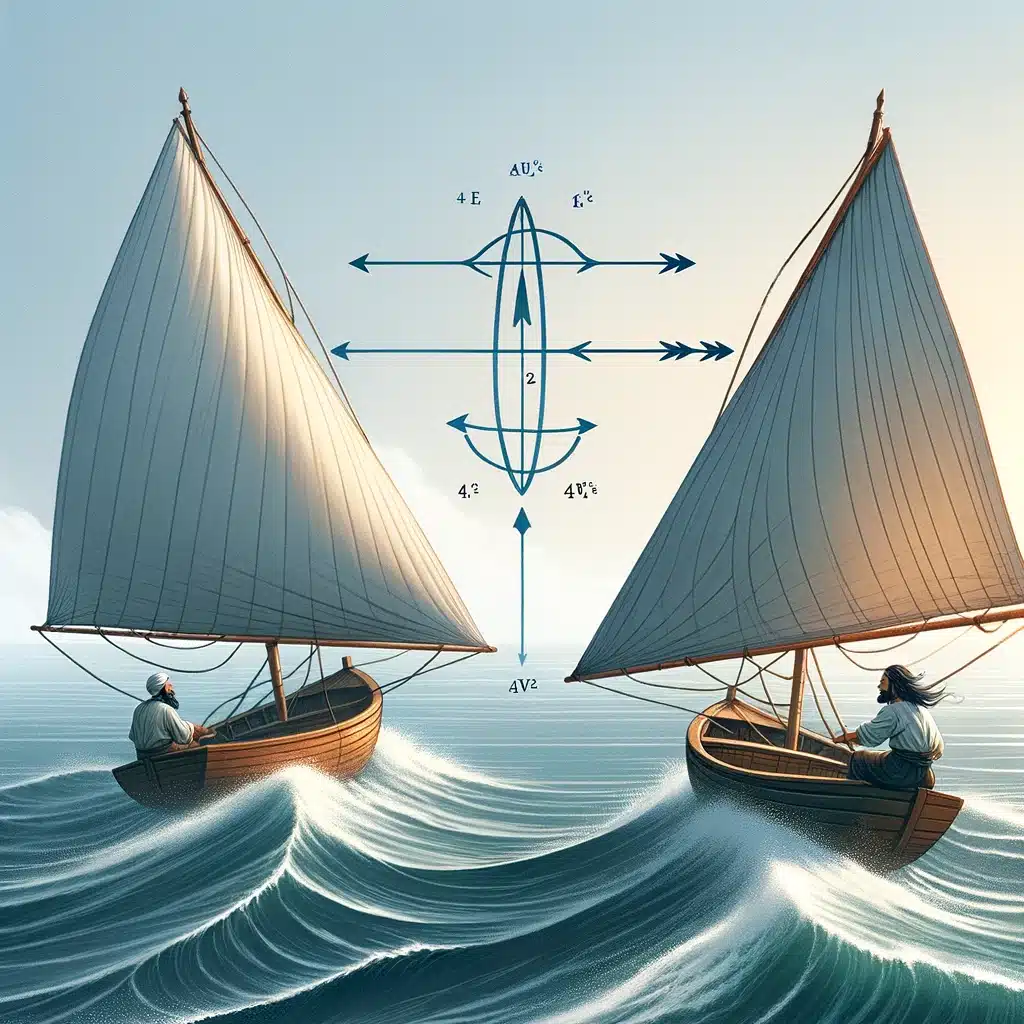Net force is a fundamental concept in physics that helps us understand the motion of objects. It refers to the overall force acting on an object, taking into account both magnitude and direction. In this blog post, we will explore how to calculate net force, determine its direction, examine special cases, delve into practical applications, and highlight common mistakes and misconceptions.
How to Calculate Net Force
The Basic Net Force Equation
To calculate net force, we need to consider all the individual forces acting on an object. The basic equation for net force is:
Here, represents the net force, and
,
,
, and so on, represent the individual forces. Each force is a vector quantity, meaning it has both magnitude and direction.
Finding Net Force without Mass or Acceleration
In some cases, we may not have information about the mass or acceleration of an object. However, we can still determine the net force using Newton’s second law of motion, which states that the net force acting on an object is equal to the mass of the object multiplied by its acceleration:
Here, represents the mass of the object, and
represents its acceleration. By knowing the values of mass and acceleration, we can calculate the net force.
Calculating Net Force with Mass and Acceleration
In situations where we have both the mass and acceleration of an object, we can directly calculate the net force using the formula:
For example, let’s consider a car with a mass of 1000 kilograms and an acceleration of 5 meters per second squared. By substituting these values into the formula, we find that the net force acting on the car is 5000 Newtons.
Determining the Direction of Net Force

Understanding Vector Components
Since force is a vector quantity, it has both magnitude and direction. To determine the direction of net force, we need to break down the forces into their vector components. This involves resolving the forces into their horizontal (x) and vertical (y) components.
Finding Net Force in X and Y Directions

To find the net force in the x and y directions, we can use the following equations:
Here, and
represent the net forces in the x and y directions, respectively.
,
,
, and so on, represent the x-components of the individual forces. Similarly,
,
,
, and so on, represent the y-components of the individual forces.
Calculating Net Force of Two Vectors

When dealing with two vectors at an angle, we can use trigonometry to find the net force. By breaking down the vectors into their x and y components and adding up the components separately, we can determine the net force.
For example, let’s consider two forces: with a magnitude of 10 Newtons at an angle of 30 degrees above the x-axis, and
with a magnitude of 5 Newtons at an angle of 60 degrees below the x-axis. By finding the x and y components of each force and summing them up, we can calculate the net force.
Special Cases in Finding Net Force

Finding Net Force with Friction
When an object is moving on a surface, there are usually forces acting on it. The net force on the object is the vector sum of all the forces, including friction, that are acting on the object. Friction is a force that opposes the relative motion or tendency of such motion of two surfaces in contact. The magnitude of the frictional force can be calculated using the formula:
where:
is the frictional force,
- is the coefficient of friction, which is a dimensionless scalar value that represents the frictional properties of the surfaces in contact,
- is the normal force, which is the component of a contact force that is perpendicular to the surface that an object contacts.
The net force is the sum of all the forces acting on an object. When considering friction, this can be written as:
where is the external force applied to the object.
Now, let’s go through a worked-out example.
Example:
Suppose a 5 kg block is sliding on a horizontal surface. An external force of 30 N is applied to the block in the direction of motion. The coefficient of friction between the block and the surface is 0.4. What is the net force acting on the block?
Step 1: Calculate the normal force (N).
Since the block is on a horizontal surface and there’s no vertical acceleration, the normal force is equal to the weight of the block.
Step 2: Calculate the frictional force (F_f).
Step 3: Calculate the net force (F_{net}).
So the net force acting on the block is 10.4 N in the direction of the applied force.
This net force will cause an acceleration according to Newton’s second law, . To find this acceleration , we can rearrange the formula:
Calculating Net Force on an Inclined Plane

When dealing with objects on an inclined plane, the gravitational force acting on the object can be resolved into two components – one perpendicular to the plane and one parallel to it. The net force on the object is the sum of all forces acting along the incline (parallel to it), taking into account the frictional force that opposes the motion. Here’s how to calculate it step by step:
1. Resolve the Forces:
The gravitational force can be broken down into two components:
- Parallel to the incline:
- Perpendicular to the incline:
where:
- is the mass of the object,
- is the acceleration due to gravity,
- is the angle of the incline.
2. Determine the Frictional Force:
The frictional force, which opposes the motion, can be calculated using:
where is the coefficient of friction and is the normal force, which equals perpendicular
if there are no other vertical forces.
3. Calculate Net Force on the Incline:
The net force along the incline is the sum of all forces parallel to the incline. If we consider an upward force along the incline to be positive, the net force can be calculated as:
Example Calculation:
Let’s calculate the net force for a 10 kg object on a 30-degree incline with an applied force of 50 N up the incline, a frictional force of 20 N, and a coefficient of friction .
1. Calculate the Weight Components:
2. Calculate the Frictional Force:
3. Calculate the Net Force:
After calculating
and
with the values obtained above, you would insert those to find
Determining Net Force in Circular Motion
In circular motion, an object experiences a centripetal force directed towards the center of the circular path. This force is responsible for keeping the object in its circular trajectory. By considering this centripetal force and other forces, we can determine the net force.
Formula for finding the net force in circular motion:
Where:
– is the net force acting on the object.
– is the mass of the object.
– is the velocity of the object.
– is the radius of the circular path.
Example:
Let’s say you have a 500-gram object moving in a circular path with a radius of 2 meters. The object has a velocity of 4 meters per second. Calculate the net force acting on the object.
Solution:
1. First, convert the mass to kilograms since the SI unit for mass is kilograms. 500 grams is equal to 0.5 kilograms.
2. Plug the values into the formula:
3. Calculate the net force:
So, the net force acting on the object is 4 Newtons.
Calculating Net Force on a Charge
To calculate the net force on a charge, you must consider all of the forces exerted by other charges in the vicinity. This involves using Coulomb’s Law, which states that the force between two point charges is directly proportional to the product of the magnitudes of the charges and inversely proportional to the square of the distance between them. The formula is given by:
Where:
is the magnitude of the force between the charges,
is Coulomb’s constant (
),
and
are the magnitudes of the charges,
is the distance between the centers of the two charges.
The force is attractive if the charges are of opposite signs and repulsive if the charges have the same sign.
Example: Calculating Net Force on a Charge
Imagine three point charges in space:
- The first charge
is
at position
.
- The second charge
is
at position
meters.
- The third charge
is
at position
meters.
We want to calculate the net force on charge .
First, calculate the force between and
:
Substitute the known values:
This force is attractive, so it acts along the line connecting and
, towards
.
Now, calculate the force between and
:
This force is repulsive, so it acts along the line connecting and
, away from
.
The net force on is the vector sum of
and
. Since these forces act at right angles to each other, we can use the Pythagorean theorem to find the resultant force
:
The direction of this force can be determined by the angle it makes with the x-axis, which can be found using trigonometry:
To determine the direction of the net force on charge , we need to consider the forces exerted by charges
and
. Since
is located above
is to the right of
, we calculate the net force direction by finding the angle ( theta ) with respect to the negative y-axis.
The force due to is directed vertically downward (negative y-direction), and the force due to
is directed horizontally to the right (positive x-direction). To calculate
, we use the arctangent function:
Substitute the values of :
The angle is measured counterclockwise from the positive x-axis and determines the direction of the net force. Since
exerts a force downward and
exerts a force to the right, the net force’s direction is in the fourth quadrant of the coordinate system.
Hence, the direction of the net force on charge is approximately
counterclockwise from the positive x-axis.
Practical Applications of Net Force
The Atwood Machine and Net Force
The Atwood machine is a mechanical device that utilizes the concept of net force. It consists of a pulley, a string, and two masses. By applying Newton’s second law and considering the net force, we can analyze the motion of the masses in the Atwood machine.
Net Force in Science and Everyday Life
Net force is a crucial concept in various scientific disciplines, including physics, engineering, and astronomy. Its understanding helps us explain and predict the motion of objects in our everyday lives, such as the movement of vehicles, the behavior of sports equipment, or the flight of a ball.
The Role of Net Force in Vehicle Motion and Safety
Net force plays a vital role in understanding the motion and safety of vehicles. By considering the net force acting on a vehicle, we can analyze its acceleration, braking, and stability. This knowledge allows us to design safer vehicles and develop strategies for accident prevention.
Worked Out Examples
Example of Finding Net Force with Given Mass and Acceleration
Let’s consider an object with a mass of 5 kilograms and an acceleration of 10 meters per second squared. To find the net force acting on the object, we can use the formula . Substituting the given values, we have
. Therefore, the net force acting on the object is 50 Newtons.
Example of Calculating Net Force on an Inclined Plane
Suppose we have an object on an inclined plane with a mass of 2 kilograms. The angle of the incline is 30 degrees, and the force of friction is 5 Newtons. The force of gravity can be resolved into two components: one parallel to the plane and one perpendicular to the plane. By considering these components and subtracting the force of friction, we can calculate the net force.
Example of Determining Net Force in Circular Motion
Consider an object moving in a circular path with a radius of 3 meters and a speed of 4 meters per second. To maintain circular motion, the object experiences a centripetal force directed towards the center of the circle. By considering this centripetal force and any other applicable forces, we can determine the net force acting on the object.
Common Mistakes and Misconceptions in Finding Net Force
Image by w:File:Non-parallel net force.jpg – Wikimedia Commons, Wikimedia Commons, Licensed under CC BY-SA 3.0.
Misunderstanding of Vector Components
One common mistake is misunderstanding vector components. It is crucial to accurately break down forces into their x and y components to correctly determine the net force in different directions.
Confusion between Net Force and Individual Forces
Sometimes, students confuse net force with individual forces. Net force represents the overall effect of all the forces acting on an object, whereas individual forces act independently on the object.
Overlooking the Effects of Friction and Air Resistance
Another common mistake is overlooking the effects of friction and air resistance. These forces can significantly impact the net force acting on an object, especially when considering real-world scenarios.
Quick Facts:
Q: What should one take into account when considering the concept of Net Force?
A: When considering net force, one should take into account that it is essentially the sum of all the forces acting upon an object. It’s necessary to note that forces come from different directions and can cancel each other out if they are equal and opposite. Meanwhile, unbalanced forces will lead to a change in motion or direction according to Newton’s first law.
Q: Can you illustrate the application of net force in a given situation?
A: Sure. Let’s imagine an object at rest on the floor. It has two main forces acting upon it: the gravitational force pulling it downward and the normal force from the floor pushing it upward. If these forces balance, the object remains at rest because the total sum of all the forces is zero, which we refer to as the net force of zero.

Q: How can diagrams be useful in understanding Net Force?
A: Diagrams can effectively help us visually understand how multiple forces are acting on an object and illustrate how these forces can add up to a net force. They can demonstrate vectors showing the direction and magnitude of each force, making it clear when forces cancel each other out or create an unbalanced, net force.
Q: What is the role of friction force in the account of net force?
A: Friction force always acts in the opposite direction of an object’s motion. If you push an object on a surface, the friction force from the surface is trying to resist or slow down this motion. Therefore, in calculating the net force, you need to count the friction force as a negative force if your push force is considered positive.
Q: What’s the standard unit of measurement for net force?
A: The standard unit of measurement for net force is the Newton (N). For example, if a 20 N force is acting to the right, and a 20 N force is also acting to the left, the net force would be 0 N because they cancel each other out.
Q: What happens when the net force is zero?
A: When the net force is zero, it means that all the forces acting on an object are balanced. As per Newton’s First Law, an object at rest tends to stay at rest, and an object in motion tends to stay in motion with the same speed and in the same direction unless acted upon by an unbalanced force. So, if the net force is zero, an object will maintain its state of motion.
How can the concepts of finding net force and calculating net force using mass and speed be combined?
The intersection between finding net force and calculating net force using mass and speed is a crucial aspect in understanding the physical forces involved in different scenarios. By considering the mass and speed of an object, the net force acting upon it can be determined. To explore this further, check out the article on “Calculating net force using mass and speed”.
Q: How can I calculate net force in a given situation?
A: To calculate net force in any given situation, you need to understand the direction and magnitude of each force acting upon an object. You add all the forces that are acting in the same direction and consider those in the opposite direction as negative. For constant forces, the net force is the sum of all these forces.
Also Read:
- How to calculate mass from gravitational force
- How to calculate tension in a string
- How to calculate speed from force and mass
- How to calculate tension between two objects
- How to calculate flux linkage
- How to calculate momentum before collision
- How to calculate instantaneous velocity formula
- How to calculate mass from force
- How to calculate mass from force and velocity
- How to calculate projectile motion

Hello, I’m Manish Naik completed my MSc Physics with Solid-State Electronics as a specialization. I have three years of experience in Article Writing on Physics subject. Writing, which aimed to provide accurate information to all readers, from beginners and experts.
In my leisure time, I love to spend my time in nature or visiting historical places.
Looking forward to connecting you through LinkedIn –
